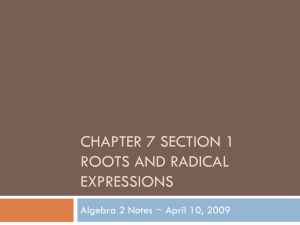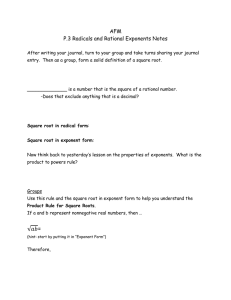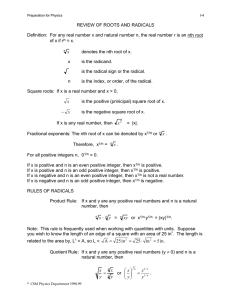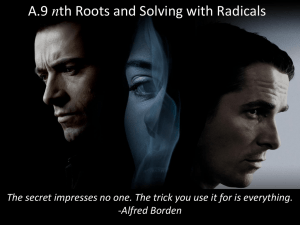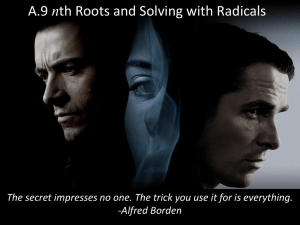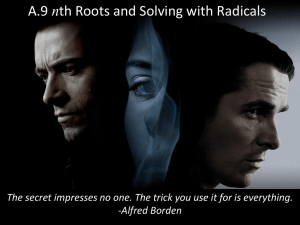Powers and Roots
advertisement
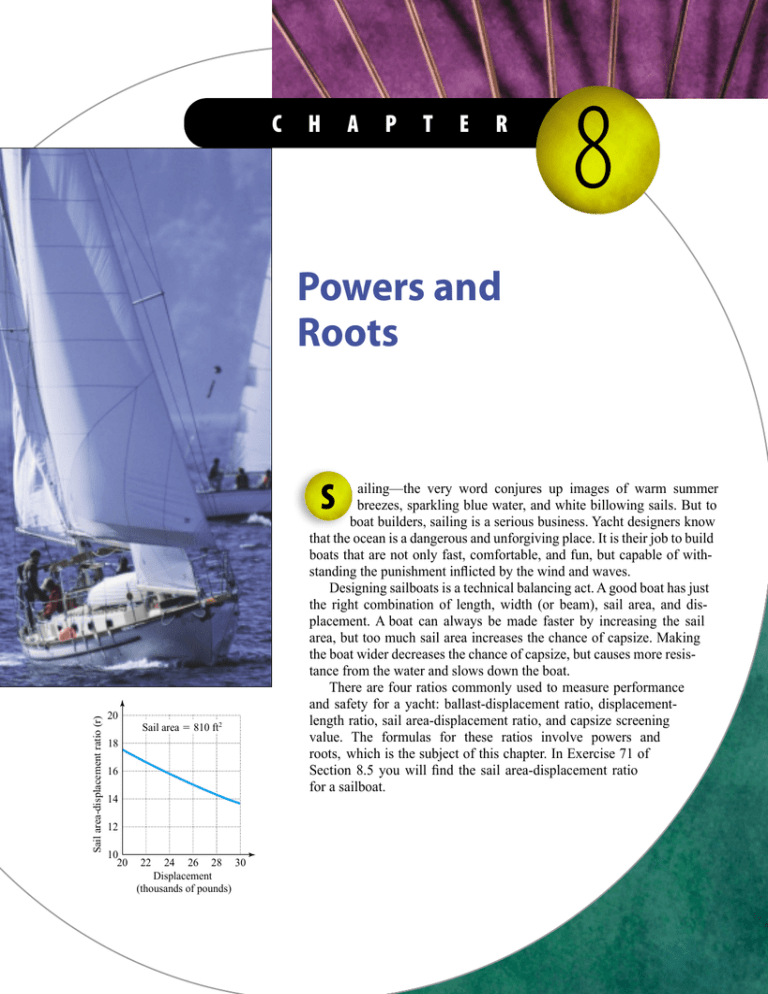
C H A P T E R 8 Powers and Roots ailing—the very word conjures up images of warm summer breezes, sparkling blue water, and white billowing sails. But to boat builders, sailing is a serious business. Yacht designers know that the ocean is a dangerous and unforgiving place. It is their job to build boats that are not only fast, comfortable, and fun, but capable of withstanding the punishment inflicted by the wind and waves. Designing sailboats is a technical balancing act. A good boat has just the right combination of length, width (or beam), sail area, and displacement. A boat can always be made faster by increasing the sail area, but too much sail area increases the chance of capsize. Making the boat wider decreases the chance of capsize, but causes more resistance from the water and slows down the boat. There are four ratios commonly used to measure performance and safety for a yacht: ballast-displacement ratio, displacementlength ratio, sail area-displacement ratio, and capsize screening value. The formulas for these ratios involve powers and roots, which is the subject of this chapter. In Exercise 71 of Section 8.5 you will find the sail area-displacement ratio for a sailboat. Sail area-displacement ratio (r) S 20 Sail area 810 ft2 18 16 14 12 10 20 22 24 26 28 30 Displacement (thousands of pounds) 414 (8-2) Chapter 8 Powers and Roots 8.1 In this section ● Fundamentals ● Roots and Variables ● Product Rule for Radicals ● Quotient Rule for Radicals ROOTS, RADICALS, AND RULES In Section 4.6 you learned the basic facts about powers. In this section you will study roots and see how powers and roots are related. Fundamentals We use the idea of roots to reverse powers. Because 32 9 and (3)2 9, both 3 and 3 are square roots of 9. Because 24 16 and (2)4 16, both 2 and 2 are fourth roots of 16. Because 23 8 and (2)3 8, there is only one real cube root of 8 and only one real cube root of 8. The cube root of 8 is 2 and the cube root of 8 is 2. nth Roots If a bn for a positive integer n, then b is an nth root of a. If a b2, then b is a square root of a. If a b3, then b is the cube root of a. If n is a positive even integer and a is positive, then there are two real nth roots of a. We call these roots even roots. The positive even root of a positive number is called the principal root. The principal square root of 9 is 3 and the principal fourth root of 16 is 2 and these roots are even roots. If n is a positive odd integer and a is any real number, there is only one real nth root of a. We call that root an odd root. Because 25 32, the fifth root of 32 is 2 and 2 is an odd root. We use the radical symbol to signify roots. n a n If n is a positive even integer and a is positive, then a denotes the principal nth root of a. n If n is a positive odd integer, thenn a denotes the nth root of a. If n is any positive integer, then 0 0. n n We read a as “the nth root of a.” In the notation a, n is the index of the radical and a is the radicand. For square roots the index is omitted, and we simply . write a E X A M P L E 1 Evaluating radical expressions Find the following roots: 3 5 b) 27 a) 2 c) 64 Solution a) Because 52 25, 2 5 5. 3 b) Because (3)3 27, 27 3. 6 c) Because 26 64, 64 2. 2, 4 (4 ) 2. d) Because 4 6 d) 4 ■ 8.1 Roots, Radicals, and Rules (8-3) 415 calculator In radical notation, 4 represents the principal square root of 4, so 4 2. Note that 2 is also a square root of 4, but 4 2. close-up Note that even roots of negative numbers are omitted from the definition of nth roots because even powers of real numbers are never negative. So no real number can be an even root of a negative number. Expressions such as We can use the radical symbol to find a square root on a graphing calculator, but for other roots we use the xth root symbol as shown. The xth root symbol is in the MATH menu. CAUTION 9, 81, and 64 4 6 are not real numbers. Square roots of negative numbers will be discussed in Section 9.5 when we discuss the imaginary numbers. Roots and Variables Consider the result of squaring a power of x: (x1)2 x 2, (x 2)2 x4, (x 3)2 x 6, and (x4)2 x8. When a power of x is squared, the exponent is multiplied by 2. So any even power of x is a perfect square. Perfect Squares The following expressions are perfect squares: x 2, calculator close-up A calculator can provide numerical support for this discussion of roots. Note that ( 3) 2 3 not 3 because 2 x x when x is negative. Note also that the calculator will not evaluate 32 be2 cause 3 9 . x4, x 6, x8, x 10, x12, ... Since taking a square root reverses the operation of squaring, the square root of an even power of x is found by dividing the exponent by 2. Provided x is nonnegative (see Caution below), we have: x2 x1 x, x4 x 2, x6 x 3, and x8 x 4. If x is negative, equations like x2 x and x6 x 3 are not correct because the radical represents the nonnegative square root but x and x 3 are negative. That is why we assume x is nonnegative. CAUTION If a power of x is cubed, the exponent is multiplied by 3: (x1)3 x 3, (x 2)3 x6, (x 3)3 x 9, and (x 4)3 x12. So if the exponent is a multiple of 3, we have a perfect cube. Perfect Cubes The following expressions are perfect cubes: x3, x6, x 9, x12, x15, ... Since the cube root reverses the operation of cubing, the cube root of any of these perfect cubes is found by dividing the exponent by 3: x 3 x 1 x, 3 x 6 x 2, x 9 x 3, and 3 3 x 12 x 4. 3 If the exponent is divisible by 4, we have a perfect fourth power, and so on. 416 (8-4) Chapter 8 E X A M P L E 2 Powers and Roots Roots of exponential expressions Find each root. Assume that all variables represent nonnegative real numbers. 3 18 5 b) t c) s30 a) x22 Solution a) x22 x11 because (x11)2 x 22. 3 18 t t 6 because (t 6)3 t18. b) 5 s 30 s 6 because one-fifth of 30 is 6. c) ■ Product Rule for Radicals Consider the expression 2 3 . If we square this product, we get calculator (2 3 )2 (2)2(3)2 Power of a product rule 23 close-up (2 )2 2 and (3 )2 3 6. You can illustrate the product rule for radicals with a calculator. The number 6 is the unique positive number whose square is 6. Because we 3 and obtained 6, we must have 6 2 3 . This examsquared 2 ple illustrates the product rule for radicals. Product Rule for Radicals The nth root of a product is equal to the product of the nth roots. In symbols, ab a b, n n n provided all of these roots are real numbers. E X A M P L E 3 calculator close-up You can illustrate the quotient rule for radicals with a calculator. Using the product rule for radicals Simplify each radical. Assume that all variables represent positive real numbers. y b) 3 y8 a) 4 Solution a) 4 y 4 y 2y b) 3 y8 3 y8 3 y4 y4 3 Product rule for radicals Simplify. Product rule for radicals y8 y4 A radical is usually written last in a product. Quotient Rule for Radicals Because 2 3 6 , we have 6 3 2 , or 2 63 .63 This example illustrates the quotient rule for radicals. ■ 8.1 Roots, Radicals, and Rules (8-5) 417 Quotient Rule for Radicals The nth root of a quotient is equal to the quotient of the nth roots. In symbols, a a n , b b provided that all of these roots are real numbers and b 0. n n In the next example we use the quotient rule to simplify radical expressions. E X A M P L E 4 Using the quotient rule for radicals Simplify each radical. Assume that all variables represent positive real numbers. 21 t 3 x a) b) 6 9 y Solution t t a) 9 9 t 3 b) 3 Quotient rule for radicals 3 x21 x21 6 3 y y6 7 x 2 y M A T H Quotient rule for radicals ■ A T W O R K 3–2–1–Blast off! Joseph Bursavich watches each Space Shuttle mission with particular attention. He is a Senior Computer Systems Designer for Martin Marietta, writing programs that support the building COMPUTER of the external tank that is the structural backbone of SYSTEMS the Space Shuttle for NASA. Each tank, made up of DESIGNER three major parts, is 157 feet long and takes almost two years to build. To date, 74 tanks have been completed, and each has done its job in carrying cargo into space. Currently, Mr. Bursavich supports a team whose objective is to develop a superlightweight tank made of a mixture of aluminum and other metals. Reducing the weight of the tank is vital to the space station program because a lighter tank means that each mission can carry a greater payload into space. Because of economic considerations, as many as ten external tanks might be produced at one time. Mr. Bursavich writes programs to determine the economic order quantity (EOQ) for components of the external tank. The EOQ depends on setup costs, labor costs, the quantity of the component to be used in one year, the cost of holding stock for one year, and maintenance costs. In Exercise 83 of this section you will use the formula that Mr. Bursavich uses to determine the EOQ for component parts of the tanks. 418 (8-6) Chapter 8 WARM-UPS Powers and Roots True or false? Explain your answer. 1. 2 2 2 3 3. 27 3 False True 4. 25 5 False True 7. 29 23 False 6. 9 3 9. If w 0, then w w. 2. What is a principal root? The principal root is the positive even root of a positive number. 3. What is the difference between an even root and an odd root? If bn a, then b is an even root provided n is even or an odd root provided n is odd. 4. What symbol is used to indicate an nth root? n The nth root of a is written as a. 5. What is the product rule for radicals? n n n The product rule for radicals says that a b ab provided all of these roots are real. 6. What is the quotient rule for radicals? n n n The quotient rule for radicals says that ab ab provided all of these roots are real. For all of the exercises in this section assume that all variables represent positive real numbers. Find each root. See Example 1. 7. 36 6 8. 4 9 7 9. 32 5 11. 1000 10. 81 10 4 13. 16 True 12 True 3 1 2 m 31. m 32. m 6 m3 33. y15 y3 34. m 8 m2 35. y15 y5 36. m 8 m4 37. m 3 m 38. x4 x 39. 3 27 40. 4 4 41. 2 42. 2 5 4 4 21. 81 3 3 6 6 10 24. 128 25. 32 27. 100 2 10 3 26. 125 28. 36 3 32 43. 5 125 3 45. 10 2 5 6 99 10 233 44. 10 1,000,000 46. 10 109 3 9 20 18 18 10 Use the product rule for radicals to simplify each expression. See Example 3. y 3y 47. 9 48. 16n 4n 49. 4a 2a 50. 36n 6n x y 51. 2 52. w t w3t m65 54. 7 z16 z87 2 4 2 2 6 2 xy 12 53. 5m 55. 8y 2y 56. 27 z2 57. 27w 3 3w 58. 125m 6 3 3 3 z2 3 3 3 5m2 3 60. 81w 3w 4 4 4 5a3y2 62. 27 z3w 15 3zw5 3 Simplify each radical. See Example 4. t 63. 4 65. 16 67. 69. y8x 1 7 2 2 61. 125a9y6 Not a real number 5 4 2 Not a real number 22. 64 4 3 0 20. 1 1 23. 64 Find each root. See Example 2. 59. 16s 2s 12. 16 3 Not a real number 3 4 18. 0 Not a real number 144 30. 16. 1 1 0 6 4 29. 50 4 Not a real number 14. 1 Not a real number 17. 1 3 4 2 3 19. 1 False 10. If t 0, then t t 3. 4 EXERCISES Reading and Writing After reading this section, write out the answers to these questions. Use complete sentences. 1. How do you know if b is an nth root of a? If bn a, then b is an nth root of a. 15. 0 True 8. 17 1 7 289 2 8. 1 3 2. 2 2 2 5. 16 2 4 3 True t 2 625 3 25 4 t t 8 2 64. 36 w w 66. 144 9 1 4 68. a 3 70. 12070y0 3 6 3 3 2x2 y 3 3 a 27 6 3 36 3y12 10 8.1 71. 49a 73. 6 4 y 16 499ab 5w 74. 81 2a3 3 2 72. y 2 4 4 4 5w 3 4 3 76. 7 0.914 5 2 77. 3 4 1.610 2 3 78. 1 5 0.257 79. 7.1 2 (1 4.2 )( 3) 200 100 0 6.001 0 10 20 30 Altitude (thousands of feet) ( 42)( 0.2 ) 3.256 80. 32 8 ( 8 )2 (1 4.3 )( 6.2 ) 82. 2(1.3) 40 FIGURE FOR EXERCISE 85 0.769 6.850 Solve each problem. 83. Economic order quantity. When a part is needed for a space shuttle external fuel tank, Joseph Bursavich at Martin Marietta determines the most economic order quantity E by using the formula E 2AS, where A is the quantity that I the plant will use in one year, S is the cost of setup for making the part, and I is the cost of holding one unit in stock for one year. Find the most economic order quantity if S $5290, A 20, and I $100. 46 84. Diagonal of a box. The length of the diagonal D of the box shown in the figure can be found from the formula D L 2 W2 H2, where L, W, and H represent the length, width, and height of the box, respectively. If the box has length 6 inches, width 4 inches, and height 3 inches, then what is the length of the diagonal to the nearest tenth of an inch? 7.8 in. 86. Sailing speed. To find the maximum speed in knots (nautical miles per hour) for a sailboat, sailors use the formula M 1.3w , where w is the length of the waterline in feet. a) If the length of the waterline for the sloop John B. is 38 feet, then what is the maximum speed for the John B.? b) Use the accompanying graph to estimate the length of the waterline for a boat for which the maximum speed is 6 knots. a) 8.0 knots b) 20 ft 10 Maximum speed (knots) 3 32 (1 4)( 2.9 ) 81. 2 419 300 View (miles) 3.968 (8-7) a) Use the formula to find the view to the nearest mile from an altitude of 35,000 feet. b) Use the accompanying graph to estimate the altitude of an airplane from which the view is 100 miles. a) 228 mi b) 7000 ft 3a 2 7b Use a calculator to find the approximate value of each expression to three decimal places. 5 75. 3 Roots, Radicals, and Rules 8 6 4 2 0 0 10 20 30 40 Waterline (feet) 50 FIGURE FOR EXERCISE 86 D GET TING MORE INVOLVED 6 in. 3 in. 87. Discussion. Determine whether each equation is correct. 5 )2 5 a) ( 4 in. FIGURE FOR EXERCISE 84 85. Buena vista. The formula V 1.22A gives the view in miles from horizon to horizon at an altitude of A feet (Delta Airlines brochure). b) ( 2 )3 2 3 3 )4 3 d) (7 )5 7 c) ( a) no b) yes c) no d) yes n 88. Writing. If x is a negative number and x n x, then what can you say about n? Explain your answer. n is odd 4 5
